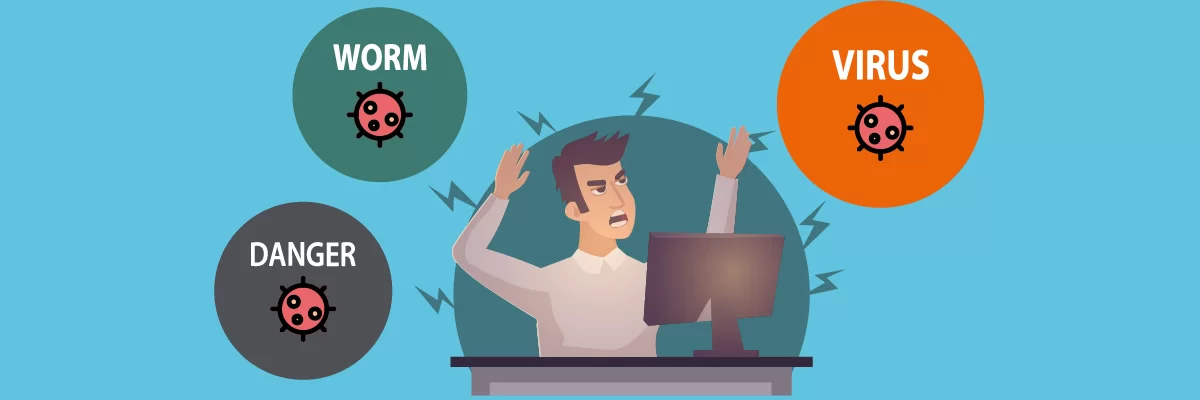Guide: What Are Computer Viruses and How to Protect Your Devices

Eddie Bingham | Hints & Tips | 30th September 2024
Table of Contents
At EB IT Support LTD, we're dedicated to helping you stay safe online. In this guide, we’ll explain what computer viruses are, how they spread, and how you can protect your devices from them. If you need assistance with virus removal or security setup, contact us at 01205 627240 or email [email protected].
What is a Computer Virus?
A computer virus is a type of malicious software (malware) that is designed to spread from one device to another. Much like a biological virus, it can replicate itself and infect new systems, often without the user’s knowledge. Viruses can corrupt files, steal data, slow down your computer, or even render it inoperable.
How Do Computer Viruses Spread?
Viruses can spread in several ways, including:
- Email Attachments: Viruses are often hidden in email attachments. Opening an infected attachment can allow the virus to infiltrate your device.
- Malicious Websites: Some websites contain viruses that automatically download to your device when you visit them.
- Infected Downloads: Downloading files from untrusted sources, including pirated software, music, or movies, can carry hidden viruses.
- Removable Media: Viruses can be transferred through USB drives, external hard drives, or other removable media that have been used on infected systems.
- File Sharing: Sharing infected files over peer-to-peer networks (P2P) or cloud storage services can spread viruses to multiple devices.
Common Types of Viruses
File Infector Virus: This type attaches itself to executable files (.exe) and spreads whenever the file is opened.
Macro Virus: Found in files like Microsoft Word or Excel documents, these viruses use macros (automated commands) to infect systems.
Boot Sector Virus: This virus infects the master boot record (MBR) of your hard drive, making it difficult to remove. It can prevent your computer from starting properly.
Polymorphic Virus: These viruses change their code slightly each time they replicate, making them difficult for antivirus software to detect.
Worms: Although not technically viruses, worms are similar. They spread across networks without needing to attach to files or programs.
Signs Your Device Might Have a Virus
- Slow Performance: Your computer or device might run much slower than normal.
- Frequent Crashes: You may experience random crashes or reboots.
- Pop-Up Ads: Unwanted pop-up ads or browser redirects may indicate a virus infection.
- Unusual Activity: Strange programs or files that you didn’t install might appear on your device.
- Disabled Security Features: Some viruses disable your antivirus software or block you from accessing security settings.
How to Protect Your Devices from Viruses
Install Antivirus Software: Make sure to install reliable antivirus software, and keep it up to date to detect and block the latest threats.
Enable Firewalls: Firewalls can help protect your device from unauthorized access and prevent certain types of virus attacks.
Keep Your System Updated: Regularly update your operating system and applications, as updates often include security patches to fix vulnerabilities that viruses could exploit.
Be Cautious with Email: Avoid opening email attachments or clicking on links from unknown or untrusted sources. If something seems suspicious, delete it.
Avoid Untrusted Downloads: Only download files, software, and apps from trusted, reputable sources like official websites or app stores.
Use Strong Passwords: Strong passwords can prevent unauthorized access to your accounts, reducing the chance of infection through compromised systems.
Backup Your Data: Regularly back up your files to an external drive or a cloud service. In case a virus infects your device, you won’t lose your important data.
How to Remove a Virus
If you suspect your device is infected, follow these steps:
- Disconnect from the Internet: This prevents the virus from spreading to other devices or communicating with its source.
- Run a Full Antivirus Scan: Use your antivirus software to run a complete system scan. If it detects a virus, follow the software’s instructions to remove it.
- Update Your Software: Ensure your operating system and all security software are updated to the latest versions.
- Seek Professional Help: If the virus persists or you’re unsure how to remove it, contact EB IT Support LTD for expert assistance.
Need Help?
If you think your device has a virus or if you need help setting up antivirus protection, don’t hesitate to contact us at 01205 627240 or email [email protected]. We’re here to ensure your devices stay secure!
Back to News
Related Articles
Christmas & New Year Closure 2024 – EB IT Support LTD - 28th October 2024
Basics of Computer Maintenance - 18th October 2024
How to Create Strong Passwords and Manage Them - 16th October 2024
How to Troubleshoot Simple Internet Connection Issues - 14th October 2024
Comments
No comments yet. Be the first to comment!